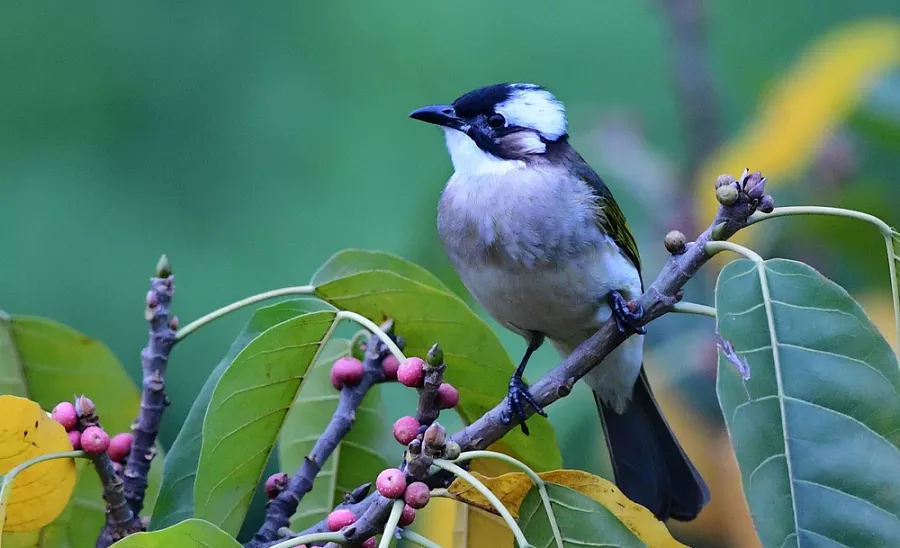The light vented bulbul (Pycnonotus sinensis), also called the Chinese bulbul, is a species of bird in the bulbul family found in central and southern China, Hong Kong, Macao, northern Vietnam, southern Japan, with occasional records from South Korea A common species of songbird that favors lightly wooded habitats, it can frequently be seen in towns, suburbs and urban parks within its range.
What does light vented bulbul look like?
The light vented bulbul is pure black and shiny from the forehead to the top of the head. There is a white stripe on both sides of the top of the head starting from the back of the eyes, extending back to the occipital to form a wide pillow ring. Some specimens have black tips on the pillow feathers. The back of some heads and pillows are all white. Cheeks, ear feathers, and cheek lines are dark brown, and the back of ear feathers turn dirty white or off-white. The upper body is brownish-gray or olive-gray, with yellow-green feather margins, forming inconspicuous dark longitudinal stripes on the upper body. Tail and wings dark brown with yellow-green plumage. The chin and throat are white, and the chest is light grayish brown, forming an inconspicuous light grayish brown horizontal band. The rest of the underparts are white or off-white, and the feather edges are yellow-green, forming sparse and inconspicuous yellow-green longitudinal stripes.
The iris is brown, the bill is black, and the feet are also black.
Light-vented bulbul habitat
It mainly inhabits shrubs, grasslands, sparse forest slopes with scattered trees, orchards, villages, farmland edge shrubs, secondary forests and bamboo forests in low mountains, hills and plains below 1000 meters above sea level, and can also be found in foothills and low mountain areas Broad-leaved forest, mixed forest and coniferous forest and their forest margins.
Light-vented bulbul living habit
Activities: Usually in small groups of 3-5 to more than 10 animals, sometimes in large groups of 20-30 animals in winter. They are mostly active on shrubs and small trees. They are lively and not very afraid of people. They often jump between branches or fly between adjacent trees, and generally do not fly long distances.
Calling: Good at singing, and the singing is mild and changeable.
Diet: Omnivorous, eating both animal food and plant food. Animal foods mainly include beetles, walking insects, golden flower beetles, turbinates, noctuids, ladybugs, locusts, snakes, bees, flies, mosquitoes, ants, long-horned fireflies, cicadas, etc. Coleoptera, Lepidoptera, Orthoptera , Hemiptera and other insects and larvae, but also eat spiders, ticks and other invertebrates. Raw plant foods mainly include wild hawthorn, wild rose, cold berry, wenmao, mulberry, heather, privet, neem, cherry, neem, grape, tallow, cabbage, blue indigo, wild jujube, camphor, catalpa and other plant fruits and seeds. According to Liang Qisang’s (1995) analysis of the annual food habits of 280 bird stomachs in Changsha, Hunan, it is shown that in January, almost all of them eat plants, and then gradually decrease until May, and almost all of them eat animal food. Sexual food increased again.
Migration: mainly resident birds, generally do not migrate.
Distribution range of Light-vented bulbul
Distributed in China, Ryukyu Islands, North Korea, South Korea, Laos, Thailand, Vietnam and other places.
Mode of reproduction
The breeding season is from April to August. Nests in shrubs or broadleaf trees, bamboo forests and conifers. The nest is 1.5-7 meters high from the ground, in the shape of a deep cup or bowl, and is composed of hay stems, grass leaves, thin trees, reeds, thatch, leaves, inflorescences, bamboo leaves and other materials. The size of the nest is 9-12 cm x 11-13 cm in outer diameter, 6-7 cm x 7-8 cm in inner diameter, 5.5-15 cm high and 4-9 cm deep. Each clutch lays 3-5 eggs, usually 4 eggs. Eggs are pink with purple spots, or white with ochre, dark gray spots or white with ochre-purple spots. The size of the eggs is 21.5-24 mm x 16-16.6 mm, and the egg weight is 2.6-3.3 grams.


 Facebook
Facebook  Instagram
Instagram  Youtube
Youtube 